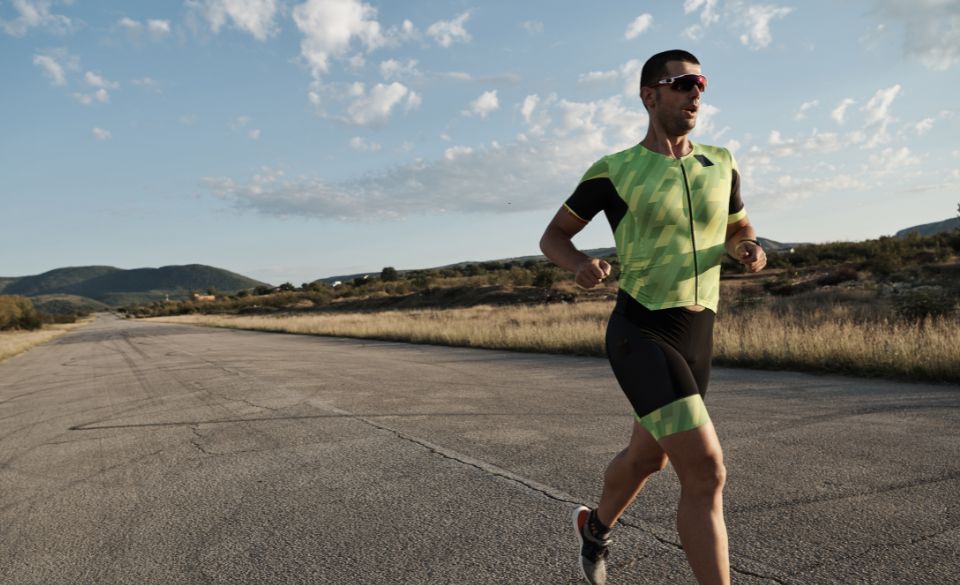
Running vs. Triathlon Running: What’s The Difference?
Page Contents
If you’re a runner considering dipping your toes into the world of triathlons, you might be wondering, “How different can running in a triathlon be from my regular 5K or marathon?” The truth is, triathlon running adds a unique layer of complexity and strategy that sets it apart from standalone running events. In this blog post, we’ll explore the key distinctions between running in a triathlon and traditional running, shedding light on what you can expect when you make the transition to multisport racing.
How is running in a triathlon different from running a 5K?
Running in a triathlon differs significantly from running a standalone 5K race in several key ways. Let’s explore these differences:
Preceding Swim and Bike Segments: Unlike a 5K race where you start fresh, a triathlon run follows a swim and bike segment. This means that your legs are already fatigued when you begin the run. The transition from swimming to running can feel awkward as you switch to different muscle groups and movement patterns. In a 5K, you start with fresh legs, giving you an immediate burst of energy.
Brick Workouts: To prepare for the swim-to-run transition, triathletes often incorporate “brick” workouts into their training. These workouts involve a combination of swimming and cycling followed immediately by running. They help your body adapt to the unique demands of transitioning between disciplines.
Multisport Mindset: In a triathlon, you’re not solely a runner; you’re a multisport athlete. This means that you must manage your energy and effort across swimming, biking, and running. You can’t push the run pace as aggressively as you might in a standalone 5K because you need to consider your overall race performance.
Pacing Strategy: Pacing in a triathlon run is critical. You need to find a pace that allows you to perform well in the run while also preserving energy for the earlier swim and bike segments. This requires a different strategy compared to a 5K where you aim for maximum speed from the start.
Race Duration: The overall duration of a triathlon is longer than that of a 5K race. Triathlons come in various distances, from sprints to Ironman events, and the run is just one part of the race. In a 5K, you’re focused on maintaining a high-intensity effort for a relatively short duration.
Transitions: Triathlons involve transitions between the swim, bike, and run. Transition areas add an extra dimension to the race, requiring athletes to change gear efficiently. This is not a factor in standalone 5K races.
Variability of Terrain: Triathlon run courses can vary widely, from pavement to trails to sand. In a 5K, the course is typically a well-defined road or track. Triathletes need to adapt to different terrains during the run portion.
Nutrition and Hydration: Managing nutrition and hydration during a triathlon is more complex due to the extended duration and multisport nature of the race. Runners in a 5K generally don’t need to worry about fueling during the race.
In summary, running in a triathlon adds complexity and strategy beyond the experience of running a standalone 5K race. The swim-to-run transition, multisport mindset, pacing strategy, and the overall duration of the race all contribute to the unique nature of triathlon running. Triathletes must adapt their training and race-day approach to excel in this multisport discipline.
How running changes in triathlon: Short course vs. long course
Short Course Triathlons
Short course triathlons, such as sprint and Olympic distance races, require a different running approach than long course events. In short course races, you can push the pace harder during the run because the overall race duration is shorter. However, you’ll need to adapt to the higher intensity and faster transitions.
Study: A study in the “Journal of Strength and Conditioning Research” analyzed the performance differences between short and long course triathlons, highlighting the need for varying running strategies based on race distance.
Long Course Triathlons
Long course triathlons, like Ironman events, demand a more conservative running strategy. The key is to avoid starting the run too aggressively, as you’ll need to conserve energy for the extended duration of the race. It’s about finding a sustainable pace that allows you to finish strong.
Study: Research in the “European Journal of Applied Physiology” examined the pacing strategies of Ironman triathletes, emphasizing the importance of pacing in long course events.
Triathlon run pace vs. your standalone run pace
Your triathlon run pace is often significantly different from your standalone run pace, and several factors contribute to these variations:
Preceding Swim and Bike Segments: In a triathlon, the run follows the swim and bike segments. These prior activities significantly impact your legs’ freshness and overall fatigue levels. As a result, your legs may feel heavier, and your running pace is likely to be slower compared to a standalone run where you start with fresh legs.
Multisport Fatigue: Triathletes need to manage their energy across swimming, biking, and running. This means that you can’t push the run pace as aggressively as you might in a standalone run. Your focus shifts from pure speed to maintaining a sustainable pace that ensures you complete the entire race effectively.
Pacing Strategy: Pacing in a triathlon run is crucial. The goal is to find a pace that allows you to perform well in the run while also preserving energy for the earlier swim and bike segments. This requires a different strategy compared to a standalone run where you aim for maximum speed throughout.
Relative Slowness: On average, triathlon run paces tend to be slower than standalone run paces. The extent of this slowdown varies based on factors such as race distance, athlete experience, and overall fitness level. For example, in a sprint triathlon, the difference may be less pronounced compared to an Ironman event.
Race Duration: Triathlons are longer-duration events than standalone runs. The run is just one part of the race, and you must consider your overall race performance. As a result, you may adopt a more conservative pace in the run to ensure you have enough energy to finish the race strong.
Transition Fatigue: Transitions between the swim, bike, and run segments add an extra layer of fatigue. Moving from one discipline to another and changing gear can impact your running performance. In a standalone run, you don’t have these transitional challenges.
Nutrition and Hydration: Managing nutrition and hydration during a triathlon run is more complex due to the extended duration and multisport nature of the race. You need to plan your fueling strategy to sustain your energy levels throughout the race, which is not a concern in a typical standalone 5K or 10K run.
In summary, your triathlon run pace is influenced by a combination of factors, including prior swim and bike segments, multisport fatigue, pacing strategy, race duration, transitions, and nutrition considerations. It’s essential for triathletes to adapt their running approach and expectations to the unique demands of multisport racing, understanding that the run pace may be slower than what they achieve in standalone running events.
How much slower will my triathlon run be?
The extent to which your triathlon run pace is slower compared to your standalone run pace can vary widely depending on several factors. While there’s no one-size-fits-all answer, here are some considerations to help you understand the potential difference:
Race Distance: The distance of the triathlon plays a significant role. In shorter distance triathlons, such as sprints and Olympic distances, the slowdown in run pace may be less pronounced. Triathletes in these events may aim for paces closer to their standalone 5K or 10K race paces.
Experience Level: Experienced triathletes who have fine-tuned their pacing strategies and transitions tend to experience less of a slowdown compared to beginners. They have learned how to manage their energy effectively across the swim, bike, and run segments.
Fitness Level: Your overall fitness and training play a crucial role. Athletes who are exceptionally fit may experience a smaller decline in run pace compared to those who are less conditioned.
Transition Efficiency: Efficient transitions can minimize the time spent in the transition area and reduce the impact on run performance. Triathletes who practice and streamline their transitions can save valuable seconds or even minutes.
Terrain and Conditions: The nature of the run course, including terrain and weather conditions, can influence your pace. Hilly courses or adverse weather may slow you down more than flat, ideal conditions.
Pacing Strategy: Your pacing strategy during the race matters. Going out too fast in the swim or bike segments can lead to excessive fatigue and a more significant slowdown in the run. Consistent pacing across all segments can help mitigate this.
Race Goals: Your goals for the triathlon also matter. If you’re primarily aiming to complete the race comfortably, you may not push the run pace as hard. In contrast, if you’re aiming for a competitive finish, you may strive for a faster run pace despite the preceding segments.
As a general guideline, some triathletes experience a slowdown of around 20 to 30 seconds per mile in their run pace compared to their standalone race paces. However, this can vary widely. Some athletes may experience a more significant slowdown, while others may see only a marginal difference, especially in shorter triathlon distances.
Final Words – Running vs Triathlon Running: What’s The Difference?
In conclusion, running in a triathlon introduces unique challenges and considerations that set it apart from standalone running events. The swim-to-run transition, the multisport mindset, race distance, and relative pace adjustments all play a role in shaping your triathlon running experience. Embrace these differences, train strategically, and remember that triathlon running isn’t solely about speed—it’s about endurance, strategy, and the satisfaction of conquering multiple disciplines in a single race. So, lace up those running shoes, dive into the world of triathlons, and discover a new dimension of running.



